Recently I had a day trip with my research group and we visited the farm of the future in The Hague, The Netherlands. At this location, they grow vegetables on the roof of an office building. This rooftop greenhouse is connected to a fish farm where they raise tilapia. This type of farming is called aquaponics. Aquaponics is the combination of aquaculture, which is raising aquatic animals, and hydroponics, which is the cultivation of plants in water. The site we visited was more of a pilot facility to test out the technique, and there were a lot of innovative ideas implemented.
Now, you might wonder who in their right mind would build a farm on top of an office building.
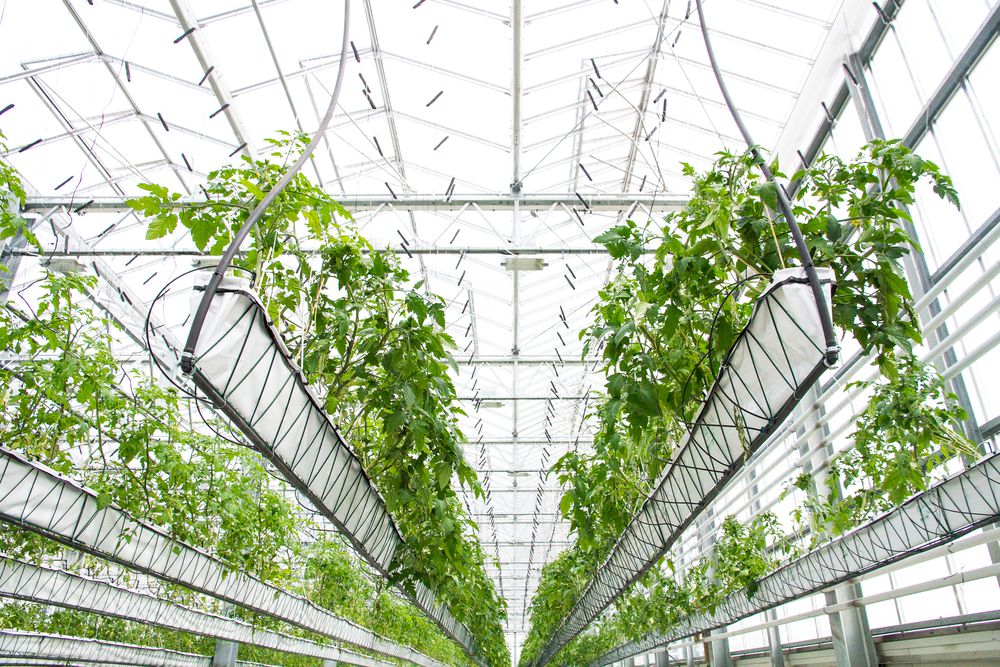
Welcome to Europe's Largest Urban Farm!
The Fresh Revolution
There are two problems this Urban Farming addresses. The first problem to mention is population density. As we have more people on this planet we will face the fact that the land we have available for agriculture is going to be limited. Combine this with the trend of people moving towards the cities, and what you get in the near future is extremely densely populated areas. The people in these areas have to be provided with fresh produce. If there are more people and there is less land available for agriculture then the availability of fresh produce will be a limiting factor.
The second problem to discuss is food miles. The food miles of a food product is the distance it travels from the farm to the consumer's plate. It is estimated that in the U.S. the average travel distance for a meal is 1.500 miles (~2400 km). Imagine the amount of greenhouse gasses that are released. Often transport routes are even inefficient because local subsidies overcome the additional costs introduced by the extra distance covered. If you could produce locally and have the food miles reduced to less than 5 miles (8 km) then a lot of energy and CO2 emission could be saved. Don’t be fooled though, transport on average represents 11% of total greenhouse gas (GHG) emission, and the final transport step (producer to retailer) is only 4%. The largest cause of emission is still production itself.
Rooftop farming
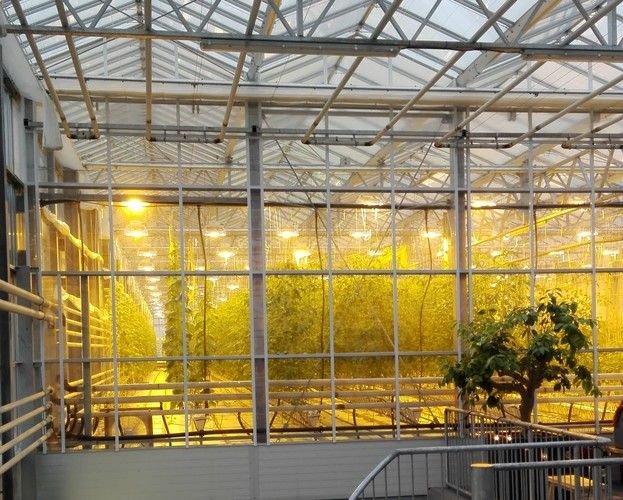
First, we visited the rooftop itself where the plants grow. We had to put on a hairnet, shoe protector, and lab-coat. Since they are not using pesticides it wasn’t to protect us, it was instead to protect the plants from us!
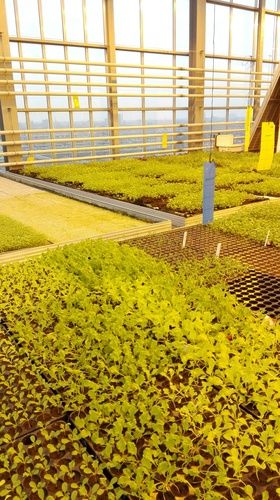
Here you see the planted seeds that grow into small plants. The plants first have to grow to a suitable size before they are transported to a larger container. These plants here are mostly varying types of lettuce and herbs.
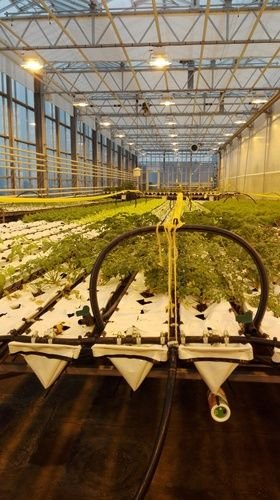
Here is where the larger plants go. The plants are supplied water from the tilapia below and this water is distributed over the plants in a way that they get similar amounts of water. The yellow tape that you see in the picture is a special sticky tape that catches little flies that eat the plants. There is a special substance on the tape that attracts the flies. In the lower-right corner of the picture, there is a little can with a green lid. These cans are spread throughout the greenhouse and contain eggs of the natural enemy of the insects that normally affect the produce: parasitoid wasps.
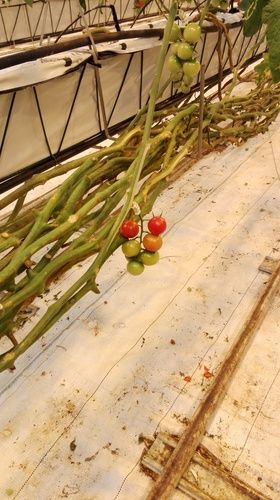
The tomatoes still needed some more time to grow!

The facility also had these vertical growers. Water would trickle down from the top and in this way, the plants are provided with water. They only had a little bit of earth to grow from, yet they grow to these large sizes. Such a technique allows farmers to put 8 plants in the same location that would normally only house one plant. Quite the improvement, although it requires more hardware.
Fish production
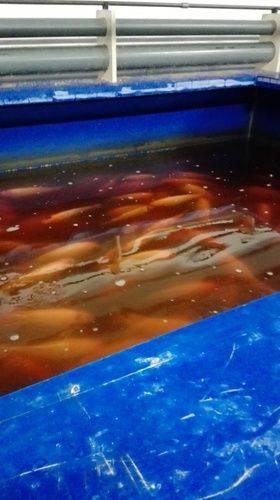
The water that the plants have cleaned is routed back to the fish, that live one floor below. These fish live in tanks and are provided with food from the green devices in the image below.
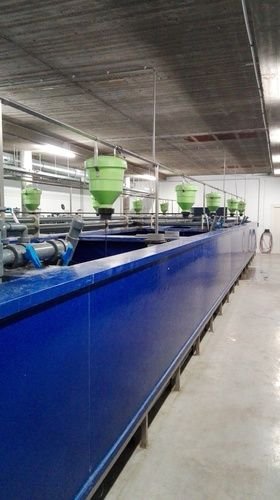
They had a good amount of tanks in this room, probably close to ~20 tanks.
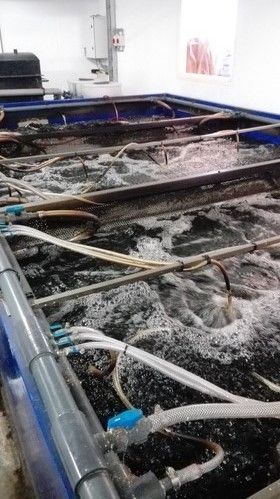
Now there is one thing that fish do if you feed them and that is pooping. The water from the fish has to go to the plants because the excrements contain a lot of the nutrients the plants require. However, their excrements also contain ammonia, which is toxic to both the fish and the plants. In the picture above they use bacteria to convert the ammonia into nitrites. The little black objects in the water are structures for the bacteria to grow on; they grow much better on a surface if they have access to it. Afterwards, the bacteria still have to be removed. This is done by an ultraviolet treatment that kills off the bacteria. The final step before the water can go to the plants is the removal of CO2.
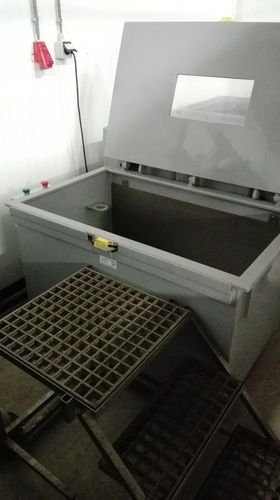
It takes about 6 to 7 months for the fish to fully grow, and then they are ready for consumption. Once they are ready they are transported into what I call the ‘kill-box’. This box is connected to a high-voltage outlet and the fish are zapped.
Conclusion
It was interesting to see aquaponics in real life. Although I don’t expect it will take off in my country The Netherlands because for the foreseeable future we have a good amount of farmland. We have no direct need for these types of initiatives. However, densely populated countries with lack of farmland would be great locations for these Urban Farms.
The closed loop of fish providing nutrients for the plants and the plants providing clean water for the fish is the key power of aquaponics, reducing 90% of the required water compared to standard farming practices.
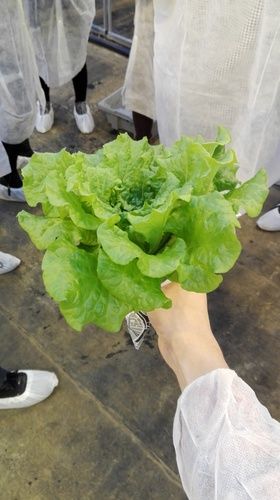
We picked our own bouquet of lettuce from the farm. This one was delicious!
References:
Urban Farmers
Cuesa
Globetrotting
Weber and Mathhews, 2008
Food Miles
Evaluating Biological Control of Brassica Pests in Urban Land Repurposed for Farming
Images:
Unsplash
Related from @Altherion
Toilet to Tap
Bioremediation: Living Cleaners
A Case for the Moon Base
Legumes: A comprehensive processing overview
The Nano World – Atomic Layer Deposition
Survival of the Fattest
by FoodLabScience
Twitter
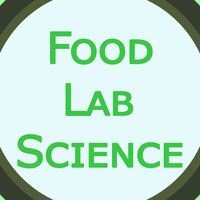
A scientist’s food for thought!
This is incredible - does the closed loop make the fish or plants more susceptible invasive disease? I imagine it requires far less, or no?, pesticides and whatnot - but if something damaging does get into the closed system does it wreak greater havoc?
Downvoting a post can decrease pending rewards and make it less visible. Common reasons:
Submit
Good question! This is indeed one of the worries of the place. The greenhouse has a wide variety of species, so they aren't that sensitive. However, the fish is all the same. One safety measure is that the species of fish they use, Tilapia, is a pretty resistant species. They are less sensitive to environmental changes and diseases. Either way they do monitor this closely.
Downvoting a post can decrease pending rewards and make it less visible. Common reasons:
Submit
due to continuous increase in population , in future every countries will adopte the farmula aquaponics, due to civilisation agricultural land are continuously reducing , so aquaponics will be substitute method
Downvoting a post can decrease pending rewards and make it less visible. Common reasons:
Submit
You're right, it's very likely. Aquaponics also avoids issues with polluted ground (i.e. heavy metals), so it's a great technique!
Downvoting a post can decrease pending rewards and make it less visible. Common reasons:
Submit
You have left me totally fascinated by this innovation in agriculture! Very good post, you explained well, you talked about the positive and the negative, I congratulate you!
Downvoting a post can decrease pending rewards and make it less visible. Common reasons:
Submit
Thank you @efren.arnaude, I appreciate the feedback!
Downvoting a post can decrease pending rewards and make it less visible. Common reasons:
Submit
Very interesting post!
Very interesting to see.
Downvoting a post can decrease pending rewards and make it less visible. Common reasons:
Submit
Thanks @syarol, it was a fun day to visit this farm.
Downvoting a post can decrease pending rewards and make it less visible. Common reasons:
Submit
Fascinating! It is good to see this kind of responsible and efficient innovation as opposed to the wasteful, forced development we see all too often these days. Thank you for sharing!
Downvoting a post can decrease pending rewards and make it less visible. Common reasons:
Submit
Sustainable agriculture is the future! It's good to see these innovations.
Downvoting a post can decrease pending rewards and make it less visible. Common reasons:
Submit
They look so advanced! But somehow, this is the future, I would say
Downvoting a post can decrease pending rewards and make it less visible. Common reasons:
Submit
Good post. Urban farming is beneficial for every household. By this activity we can get fresh fruits and vegetables. This is good idea provided to the community. Thanks for sharing knowledge.
Downvoting a post can decrease pending rewards and make it less visible. Common reasons:
Submit
These could also be very fun community projects. Produce food locally and learn about agriculture.
Downvoting a post can decrease pending rewards and make it less visible. Common reasons:
Submit
Congratulations @altherion! You have completed some achievement on Steemit and have been rewarded with new badge(s) :
Click on any badge to view your own Board of Honor on SteemitBoard.
For more information about SteemitBoard, click here
If you no longer want to receive notifications, reply to this comment with the word
STOPDownvoting a post can decrease pending rewards and make it less visible. Common reasons:
Submit
farming future model
Downvoting a post can decrease pending rewards and make it less visible. Common reasons:
Submit